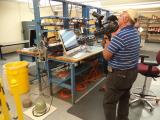SEED: Standard for the Exchange of Earthquake Data
The Standard for the Exchange of Earthquake Data (SEED) is an international standard format for the exchange of digital seismological data. SEED was designed for use by the earthquake research community, primarily for the exchange between institutions of unprocessed earth motion data. It is a format for digital data measured at one point in space and at equal intervals of time.
The SEED reference manual (version 2.4) is published by the Federation of Digital Seismographic Networks (FDSN), the Incorporated Research Institutions for Seismology (EarthScope), and the United States Geological Survey (USGS).




